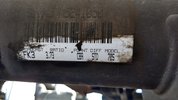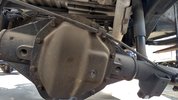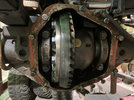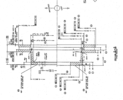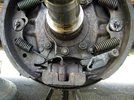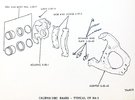Well, pirate seems like a place I'm no longer interested in sharing my tech with, so I'm moving the Bible here!
Here is a copy/paste of the bulk of the info I've compiled. I'm going to skim through it and grab any additional useful info I see. Enjoy the tech!
-Redd
The Dana 70 thread.
Welcome to the 70 bible. I don't claim to be the be-all, end-all, expert on these, although I have learned quite a bit about them while assembling this. If you have good info to share, post it up. If you want to know what version of the 70 you have, read this and look for yourself.
I want to add more info about the Super 70 (the 70-1SU?) to this, if you have any or know where to find any good info, please share with the class.
Identification...
The 70 uses (basically) the same cover as a 60 (everyone knows how to spot a 60 right?). The bolt pattern is the exactly the same and for all practical purposes the covers are interchangeable (btw a high pinion 60 cover is a nice way to get oil up to the pinion bearings in cases of steep pinion angles on a 60 or a 70). The easiest way to tell a 70 from a 60 is the lip on the bottom of the pumpkin. Most stock 70 covers will cover all the way to the bottom of the 70 housing, but the mounting lip is about 1/2" wider than a 60. With a 60 cover on a 70, the thicker lip is very obvious, but with the stocker you may have to look closer.
There are a lot of different versions of the 70, for the most part the parts are pretty interchangeable between them. They came in trucks, vans, and industrial equipment in a wide variety of widths, with bolt patterns ranging from heavy duty 6 lug, the standard 8x6.5”, and up to 10 lug, and have several different spline counts available. The majority of them are 8 lug, with 35 spline or 32 spline shafts.
The tubes are fatter than a 60, and thicker than a 14 bolt. My 70-B uses 3-9/16" OD tubes (a 60 front or rear is typically 3-1/8" OD). The 70-HD has 4" OD tubes. Tube thickness seems to be ½” on pretty much all of them (a 10.5" 14 bolt only has 3/8" wall weld seam tubing, haha!). The tapered down sections are rolled smaller, so the wall gets thicker in these sections (a 14 bolt uses friction welded spindles, haha again!).
Here is a pic of a 70-B (probably the single most common variant), showing both the lip on the bottom (that is a high pinion 60 cover on it), the lip on the top, and the taper down on the tubes (note that I cut the stock brake flanges off). The wider top and bottom lips are not normally so obvious, because factory 70 covers have wider flanges, so look closely when your axle hunting.
The lip on the bottom can be shaved down for the same ground clearance as a 60. I reccomend using a saw to remove most of the material, then finishing it out with a grinder.

Here's a better view of the taper down...

Variations...
There are several versions of the 70:
*70 (.500" pinion offset, used from late 1950's to '71 according to dana) these would likely have the lower spline counts, least desirable
*70-B (.625" offset, '71-82) Probably the most common version. Generally 35 spline, but checking is the only sure way.
*70-U (.625" offset, '82+) There seems to be less of these than the 70-B. Known as the "Teardrop 70" because of it's smooth underside. Shares all bearings with the 60
*70-2U (unknown offset) same pinion and carrier bearings as U, but big wheel bearings.
*70-HD (.625" offset, '68+) These come in big trucks, lots of them out there but many in weird widths.
*70-3HD (.969" offset, '87+) Out of newer trucks, not a lot of low gears available for these ones.
*70-High Pinion (unkown offset, 2000ish+ Kodiak/Top Kick K4500/K5500 fronts) 10 lug high pinion 70, with 1550 joints (a 60 uses 1480) 5.13 gears are the only ones available for these axles.
*70-1SU (.625” offset) Super 70. Little info available, Dana lists only available ratios as 4.10 and 4.56. Teardrop housing and HD tubes and outers.
Often the variation will be cast into the housing, but not always, and in the case of the 3HD, it may be labeled as 2HD according to rocklobster87. The only way to know for sure is to check the BOM number. It is a 6 digit number, typically starting with a 6, stamped into the axle tube just to the right of the diff, when looking at the cover. Go to www2.dana.com and look it up to see what you’ve got.
The 70-U uses a smaller pinion bearing than any of the others (the same as a 60) All the others use the same inner pinion bearing. Carrier bearings and outer pinion bearing are the same as a 60. Wheel bearings vary, and can range from the same part numbers as 60’s and 14 bolts, to bigger.
The carrier bearings on the 70, 70-B and 70-U are all the same size (same bearings as a 60 carrier). The HD carrier is .125” narrower than the others, and can be use in the other 70’s with the addition of a 1/8” spacer. This leads me to assume that a normal 70 carrier won’t fit in a HD.
Because of the different pinion offsets available, it’s important to know exactly what you have when looking for gears and carriers.
If there are other ways to distinguish the variations with visual checks, post up what you know and pics if you can so we can make this as complete as possible.
Differences and similarities with the 60...
The std 70 uses some of the same bearings as the 60, the outer pinion bearing is the same one (splines and seals are also the same as a 60, so yokes are totally interchangeable), but the inner pinion bearing is significantly bigger. The carrier bearings are the same as a 60 also.
The inner wheel bearings are bigger than a 60, but the outers are the same. Here is a pic of a 4.10 pinion out of a 60 and one out of a 70. The bearing in front of each pinion is the inner wheel bearing. Which is the 60 and which is the 70 is pretty obvious.

Here's another view...

Shafts...
There are also different axle shaft spline counts available. The 35 spline is the most desirable (and I believe the most common too). Off the top of my head, here's the list, 16(?), 23, 30, 32 and 35 spline. Can anyone confirm these, I'm like 80% sure about those #'s.
Donor vehicles...
There are just about a million different applications that came with Dana 70 axles. There are too many to make a useful list. There are links to Dana's backdoor website below that list most of the applications. There is a ton of info in them, so make sure you're in a comfortable chair if you choose to navigate through them.
Misc info...
The ring gear diameter is 10.5"
The 35 spline versions are the same spline as the 35 spline 60’s and 9 inches we are all used to
The pinion nut requires a 1-5/16” thin wall socket, and should not be torqued beyond 300 lb/ft
The axle shaft flanges are typically larger than 14b and 60’s, and often use tapered cone washers on studs :smokin:
The oil capacity is about 3 quarts, Dana recommends 80w90 gear oil
The housing is ductile iron (a high quality type of cast iron)
The input torque rating is 7000 lb/ft max, 1750 lb/ft continuous for most (all?) versions from what I have gathered, the main differences are in the GVW rating.
Swapping SRW hubs on a DRW housing will make the axle effectively wider, not narrower.
Disk brake swaps are pretty much just as straightforward as they are on a 60. ¾ ton GM D44/10bolt front rotors, and the common 7-1/16” GM calipers.
Helpful Links
Dana BOM lookup page
Dana 70 Maintenance Guide
Dana 60/70 Powr-Lok LSD Service Manual
Dana Ring and Pinion Pattern guide
Dana shim kits
Ford application guide 1995-2005 (70 info p.34 to p.39)
Dodge application guide 1999-2001 (70 info p.40 to p.44)
Dana axle application/BOM guide 1979-1998 (all models, not just 70)
Dana axle application/BOM guide 1967-1978 (all models, not just 70)
Dana Light Axle General Information Guide, about a million applications and their BOMs (for all models, not just 70), from 1979-2005)
I'm planning on updating this post with anything you guys have to add, since it's missing more info than it has. It should make a pretty handy reference for all us 70 fans.
-Redd
Last edited by reddman; 11-13-2010 at 07:29 PM.
Here is a copy/paste of the bulk of the info I've compiled. I'm going to skim through it and grab any additional useful info I see. Enjoy the tech!
-Redd
The Dana 70 thread.
Welcome to the 70 bible. I don't claim to be the be-all, end-all, expert on these, although I have learned quite a bit about them while assembling this. If you have good info to share, post it up. If you want to know what version of the 70 you have, read this and look for yourself.
I want to add more info about the Super 70 (the 70-1SU?) to this, if you have any or know where to find any good info, please share with the class.
Identification...
The 70 uses (basically) the same cover as a 60 (everyone knows how to spot a 60 right?). The bolt pattern is the exactly the same and for all practical purposes the covers are interchangeable (btw a high pinion 60 cover is a nice way to get oil up to the pinion bearings in cases of steep pinion angles on a 60 or a 70). The easiest way to tell a 70 from a 60 is the lip on the bottom of the pumpkin. Most stock 70 covers will cover all the way to the bottom of the 70 housing, but the mounting lip is about 1/2" wider than a 60. With a 60 cover on a 70, the thicker lip is very obvious, but with the stocker you may have to look closer.
There are a lot of different versions of the 70, for the most part the parts are pretty interchangeable between them. They came in trucks, vans, and industrial equipment in a wide variety of widths, with bolt patterns ranging from heavy duty 6 lug, the standard 8x6.5”, and up to 10 lug, and have several different spline counts available. The majority of them are 8 lug, with 35 spline or 32 spline shafts.
The tubes are fatter than a 60, and thicker than a 14 bolt. My 70-B uses 3-9/16" OD tubes (a 60 front or rear is typically 3-1/8" OD). The 70-HD has 4" OD tubes. Tube thickness seems to be ½” on pretty much all of them (a 10.5" 14 bolt only has 3/8" wall weld seam tubing, haha!). The tapered down sections are rolled smaller, so the wall gets thicker in these sections (a 14 bolt uses friction welded spindles, haha again!).
Here is a pic of a 70-B (probably the single most common variant), showing both the lip on the bottom (that is a high pinion 60 cover on it), the lip on the top, and the taper down on the tubes (note that I cut the stock brake flanges off). The wider top and bottom lips are not normally so obvious, because factory 70 covers have wider flanges, so look closely when your axle hunting.
The lip on the bottom can be shaved down for the same ground clearance as a 60. I reccomend using a saw to remove most of the material, then finishing it out with a grinder.
Here's a better view of the taper down...
Variations...
There are several versions of the 70:
*70 (.500" pinion offset, used from late 1950's to '71 according to dana) these would likely have the lower spline counts, least desirable
*70-B (.625" offset, '71-82) Probably the most common version. Generally 35 spline, but checking is the only sure way.
*70-U (.625" offset, '82+) There seems to be less of these than the 70-B. Known as the "Teardrop 70" because of it's smooth underside. Shares all bearings with the 60
*70-2U (unknown offset) same pinion and carrier bearings as U, but big wheel bearings.
*70-HD (.625" offset, '68+) These come in big trucks, lots of them out there but many in weird widths.
*70-3HD (.969" offset, '87+) Out of newer trucks, not a lot of low gears available for these ones.
*70-High Pinion (unkown offset, 2000ish+ Kodiak/Top Kick K4500/K5500 fronts) 10 lug high pinion 70, with 1550 joints (a 60 uses 1480) 5.13 gears are the only ones available for these axles.
*70-1SU (.625” offset) Super 70. Little info available, Dana lists only available ratios as 4.10 and 4.56. Teardrop housing and HD tubes and outers.
Often the variation will be cast into the housing, but not always, and in the case of the 3HD, it may be labeled as 2HD according to rocklobster87. The only way to know for sure is to check the BOM number. It is a 6 digit number, typically starting with a 6, stamped into the axle tube just to the right of the diff, when looking at the cover. Go to www2.dana.com and look it up to see what you’ve got.
The 70-U uses a smaller pinion bearing than any of the others (the same as a 60) All the others use the same inner pinion bearing. Carrier bearings and outer pinion bearing are the same as a 60. Wheel bearings vary, and can range from the same part numbers as 60’s and 14 bolts, to bigger.
The carrier bearings on the 70, 70-B and 70-U are all the same size (same bearings as a 60 carrier). The HD carrier is .125” narrower than the others, and can be use in the other 70’s with the addition of a 1/8” spacer. This leads me to assume that a normal 70 carrier won’t fit in a HD.
Because of the different pinion offsets available, it’s important to know exactly what you have when looking for gears and carriers.
If there are other ways to distinguish the variations with visual checks, post up what you know and pics if you can so we can make this as complete as possible.
Differences and similarities with the 60...
The std 70 uses some of the same bearings as the 60, the outer pinion bearing is the same one (splines and seals are also the same as a 60, so yokes are totally interchangeable), but the inner pinion bearing is significantly bigger. The carrier bearings are the same as a 60 also.
The inner wheel bearings are bigger than a 60, but the outers are the same. Here is a pic of a 4.10 pinion out of a 60 and one out of a 70. The bearing in front of each pinion is the inner wheel bearing. Which is the 60 and which is the 70 is pretty obvious.
Here's another view...
Shafts...
There are also different axle shaft spline counts available. The 35 spline is the most desirable (and I believe the most common too). Off the top of my head, here's the list, 16(?), 23, 30, 32 and 35 spline. Can anyone confirm these, I'm like 80% sure about those #'s.
Donor vehicles...
There are just about a million different applications that came with Dana 70 axles. There are too many to make a useful list. There are links to Dana's backdoor website below that list most of the applications. There is a ton of info in them, so make sure you're in a comfortable chair if you choose to navigate through them.
Misc info...
The ring gear diameter is 10.5"
The 35 spline versions are the same spline as the 35 spline 60’s and 9 inches we are all used to
The pinion nut requires a 1-5/16” thin wall socket, and should not be torqued beyond 300 lb/ft
The axle shaft flanges are typically larger than 14b and 60’s, and often use tapered cone washers on studs :smokin:
The oil capacity is about 3 quarts, Dana recommends 80w90 gear oil
The housing is ductile iron (a high quality type of cast iron)
The input torque rating is 7000 lb/ft max, 1750 lb/ft continuous for most (all?) versions from what I have gathered, the main differences are in the GVW rating.
Swapping SRW hubs on a DRW housing will make the axle effectively wider, not narrower.
Disk brake swaps are pretty much just as straightforward as they are on a 60. ¾ ton GM D44/10bolt front rotors, and the common 7-1/16” GM calipers.
Helpful Links
Dana BOM lookup page
Dana 70 Maintenance Guide
Dana 60/70 Powr-Lok LSD Service Manual
Dana Ring and Pinion Pattern guide
Dana shim kits
Ford application guide 1995-2005 (70 info p.34 to p.39)
Dodge application guide 1999-2001 (70 info p.40 to p.44)
Dana axle application/BOM guide 1979-1998 (all models, not just 70)
Dana axle application/BOM guide 1967-1978 (all models, not just 70)
Dana Light Axle General Information Guide, about a million applications and their BOMs (for all models, not just 70), from 1979-2005)
I'm planning on updating this post with anything you guys have to add, since it's missing more info than it has. It should make a pretty handy reference for all us 70 fans.
-Redd
Last edited by reddman; 11-13-2010 at 07:29 PM.
Last edited:



